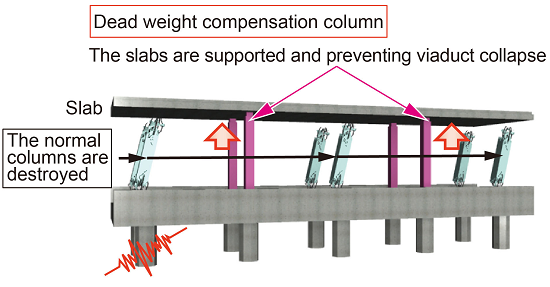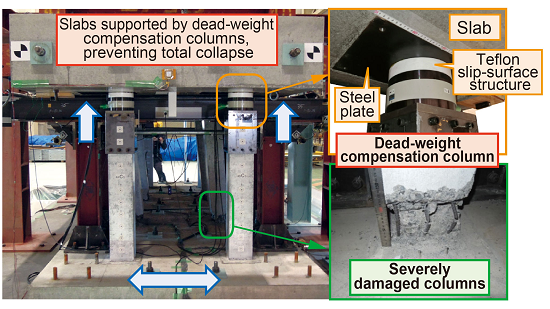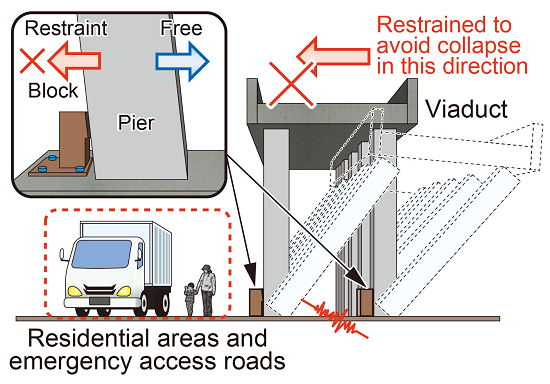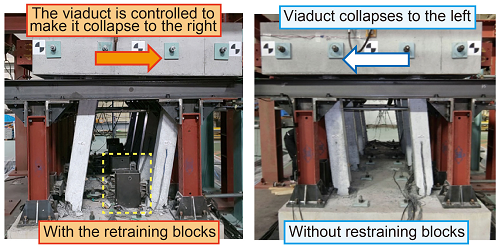4. Seismic reinforcement methods for improving anti-catastrophe performance of railway viaducts
Railway structures are built according to seismic design requirements to guarantee safety and durability.
However, it is impossible to say that in future they will not be subject to unexpectedly powerful earthquakes.
Consequently, a dead-weight compensation structure and collapsing-direction control structure were developed in order to increase the seismic resistance of new and existing viaducts.
The dead-weight compensation structure ensures that even if a viaduct’s piers are temporarily destroyed, a back-up set of piers (dead-weight compensation columns) come into play to support the vertical load of the viaduct slabs, thereby preventing total collapse (Fig. 1).
The tops of the dead weight compensation columns are equipped with a Teflon slipping surface, severing the connection with the viaduct and horizontal movement.
Consequently, the structure protects the piers from damage due to inertial force, and they are able to support the vertical load of the slabs. The results of loading tests confirmed that the structure with dead-weight compensation columns prevented the collapse of the viaduct even when its piers were severely damaged by the shaking (Fig. 2).
Were the viaduct to collapse, the collapse-direction control structure artificially controls the fall direction, thereby protecting adjacent residential areas and emergency access roads, etc. (Fig. 3).
As shown in Fig. 3, a block-shaped device has been introduced to prevent the structure from collapsing in the undesirable direction. Results from shaking table tests confirmed that the direction of fall (to the right) could be controlled when subjected to vibrations equivalent to over twice the current level required in seismic design (Fig. 4).
In addition to these large-scale tests, design methods for applying the proposed methods to real structures were proposed, based on a response analysis methods, resilience evaluation method, and design method, etc.
Other Contents
- 1. Real-time hazard mapping system for localized heavy rainfall-induced disasters
- 2. Earthing system testing device for lightning protection in power supply installations
- 3. Vertical damper to suppress decrease in wheel load on container wagon bogies
- 4. Seismic reinforcement methods for improving anti-catastrophe performance of railway viaducts
- 5. Support System for verifying evacuation safety in case of station fire
- 6. Early railway line tsunami inundation forecasting method
- 7. System for determining the stability of slopes during snowmelt season
- 8. Measures for reducing damage to overhead contact line system due to bridge oscillations caused by passing trains
- 9. VR-based training to prevent man-vehicle collision accidents
- 10. Method for evaluating train running safety during earthquakes considering non-linear behaviour of structures
- 11. Critical wind speed of overturning based on actual measured lateral vibration acceleration
- 1. Real-time hazard mapping system for localized heavy rainfall-induced disasters
- 2. Earthing system testing device for lightning protection in power supply installations
- 3. Vertical damper to suppress decrease in wheel load on container wagon bogies
- 4. Seismic reinforcement methods for improving anti-catastrophe performance of railway viaducts
- 5. Support System for verifying evacuation safety in case of station fire
- 6. Early railway line tsunami inundation forecasting method
- 7. System for determining the stability of slopes during snowmelt season
- 8. Measures for reducing damage to overhead contact line system due to bridge oscillations caused by passing trains
- 9. VR-based training to prevent man-vehicle collision accidents
- 10. Method for evaluating train running safety during earthquakes considering non-linear behaviour of structures
- 11. Critical wind speed of overturning based on actual measured lateral vibration acceleration




